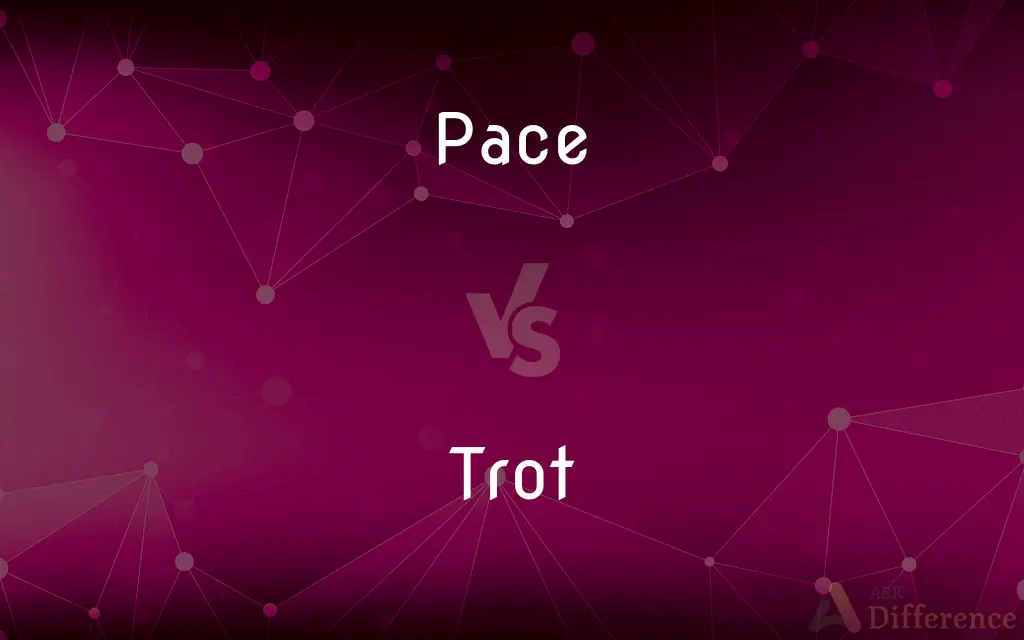Pace vs. Trot — What's the Difference?
By Tayyaba Rehman & Maham Liaqat — Updated on April 15, 2024
Pace is a lateral gait where a horse moves in a two-beat movement, whereas trot is a diagonal gait with a similar rhythm but different leg movement.

Difference Between Pace and Trot
Table of Contents
ADVERTISEMENT
Key Differences
In the world of horse gaits, pace is defined by a horse moving both legs on one side of its body simultaneously, resulting in a side-to-side motion. On the other hand, the trot involves a horse moving its diagonal legs together (left front with right hind and vice versa), creating a more up-and-down motion.
The pace is often seen as smoother due to the lack of vertical movement, which can be more comfortable for the rider. Conversely, the trot is considered to provide a bouncier ride, which can be challenging for beginner riders to manage.
Gaited horses, which are bred specifically for their ability to perform smooth lateral movements, typically excel at pacing. Whereas, most horses, regardless of breed, can perform a trot, making it a universal gait across different types of horses.
The pace can sometimes lead to faster movements, making it a preferred gait in harness racing. In contrast, the trot is often used in equestrian disciplines that require precise, controlled movements, such as dressage.
Training for pacing may require specific conditioning and reinforcement of lateral movements, which is distinct from the balanced approach needed for training a horse to trot effectively.
ADVERTISEMENT
Comparison Chart
Leg Movement
Moves legs on one side simultaneously
Moves diagonal legs together
Gait Pattern
Two-beat, lateral
Two-beat, diagonal
Ride Comfort
Smoother, less vertical movement
Bouncier, more vertical movement
Typical Usage
Preferred in harness racing
Common in dressage and general riding
Training
Focus on lateral balance
Focus on diagonal balance
Compare with Definitions
Pace
Often associated with a smoother ride due to less vertical motion.
Riders prefer pacing for long distances because it's less tiring.
Trot
A fundamental gait in many equestrian sports.
Dressage tests frequently assess the horse's ability to trot with precision.
Pace
Seen as faster and more efficient in some racing contexts.
In harness races, pacing horses often outperform their trotting counterparts.
Trot
A diagonal two-beat gait where a horse moves its diagonal legs in unison.
The young foal learned to trot, its movements awkward but improving.
Pace
A lateral two-beat gait of a horse where the legs on the same side move together.
The horse switched from a trot to a pace, gliding smoothly along the track.
Trot
Requires balance and coordination to master.
The rider practiced daily to improve her balance at the trot.
Pace
May require specialized training to achieve.
The trainer spent weeks teaching the horse how to properly pace.
Trot
Known for its bouncing motion, which can be challenging to sit.
Learning to sit the trot is a fundamental skill for novice equestrians.
Pace
Common in certain breeds like Standardbreds.
Standardbreds excel at pacing, often used in harness racing.
Trot
A universal gait seen across all breeds of horses.
From Shetland ponies to Thoroughbreds, all horses can trot.
Pace
A single step taken when walking or running
Kirov stepped back a pace
Trot
The trot is a two-beat diagonal gait of the horse where the diagonal pairs of legs move forward at the same time with a moment of suspension between each beat. It has a wide variation in possible speeds, but averages about 13 kilometres per hour (8.1 mph).
Pace
Speed in walking, running, or moving
He's an aggressive player with plenty of pace
The ring road allows traffic to flow at a remarkably fast pace
Trot
The gait of a horse or other four-footed animal, between a walk and a canter in speed, in which diagonal pairs of legs move forward together.
Pace
Walk at a steady speed, especially without a particular destination and as an expression of anxiety or annoyance
We paced up and down in exasperation
She had been pacing the room
Trot
A ride on a horse moving with this gait.
Pace
Move or develop (something) at a particular rate or speed
Our fast-paced daily lives
The action is paced to the beat of a perky march
Trot
A gait of a person, faster than a walk; a jog.
Pace
With due respect to (someone or their opinion), used to express polite disagreement or contradiction
Narrative history, pace some theorists, is by no means dead
Trot
(Sports) A race for trotters.
Pace
A step made in walking; a stride.
Trot
See pony.
Pace
A unit of length equal to 30 inches (0.76 meter).
Trot
Trots(Informal) Diarrhea. Used with the.
Pace
The modern version of the Roman pace, measuring five English feet. Also called geometric pace.
Trot
A toddler.
Pace
Thirty inches at quick marching time or 36 at double time.
Trot
(Archaic) An old woman.
Pace
Five Roman feet or 58.1 English inches, measured from the point at which the heel of one foot is raised to the point at which it is set down again after an intervening step by the other foot.
Trot
To go or move at a trot.
Pace
The rate of speed at which a person, animal, or group walks or runs.
Trot
To proceed rapidly; hurry.
Pace
The rate of speed at which an activity or movement proceeds.
Trot
To cause to move at a trot.
Pace
A manner of walking or running
A jaunty pace.
Trot
An ugly old woman, a hag.
Pace
A gait of a horse in which both feet on one side are lifted and put down together.
Trot
A gait of a four-legged animal between walk and canter, a diagonal gait (in which diagonally opposite pairs of legs move together).
Pace
To walk or stride back and forth across
Paced the floor nervously.
Trot
A gait of a person or animal faster than a walk but slower than a run.
Pace
To measure (a space) by counting the number of steps needed to cover a distance.
Trot
A brisk journey or progression.
We often take the car and have a trot down to the beach.
In this lesson we'll have a quick trot through Chapter 3 before moving on to Chapter 4.
Pace
To walk (a number of steps) in so measuring a space.
Trot
A toddler.
Pace
To set or regulate the rate of speed for (a race or a competitor in a race).
Trot
(obsolete) A young animal.
Pace
To lead (one's team or teammates) with a good performance
Paced her team to a victory with 18 points.
Trot
(dance) A moderately rapid dance.
Pace
To advance or develop (something) for a particular purpose or at a particular rate
Paced the lectures so as not to overwhelm the students.
Trot
A succession of heads thrown in a game of two-up.
Pace
To train (a horse) in a particular gait, especially the pace.
Trot
A run of luck or fortune.
He′s had a good trot, but his luck will end soon.
Pace
To walk with long deliberate steps.
Trot
Synonym of horse}} {{gloss
Pace
To go at the pace. Used of a horse or rider.
Trot
Diarrhoea.
He's got a bad case of the trots and has to keep running off to the toilet.
Pace
With the permission of; with deference to. Used to express polite or ironically polite disagreement
I have not, pace my detractors, entered into any secret negotiations.
Trot
A genre of Korean pop music employing repetitive rhythm and vocal inflections.
Pace
Step.
Trot
(intransitive) To move along briskly; specifically, to move at a pace between a walk and a run.
I didn't want to miss my bus, so I trotted the last few hundred yards to the stop.
The dog trotted along obediently by his master's side.
Pace
A step taken with the foot.
Trot
To move at a gait between a walk and a canter.
Pace
The distance covered in a step (or sometimes two), either vaguely or according to various specific set measurements.
Even at the duel, standing 10 paces apart, he could have satisfied Aaron’s honor.
I have perambulated your field, and estimate its perimeter to be 219 paces.
Trot
(transitive) To cause to move, as a horse or other animal, in the pace called a trot; to cause to run without galloping or cantering.
Pace
Way of stepping.
Trot
To bid against (a person) at an auction, so as to raise the price of the goods.
Pace
A manner of walking, running or dancing; the rate or style of how someone moves with their feet.
Trot
Fig.: To run; to jog; to hurry.
He that rises late must trot all day, and will scarcely overtake his business at night.
Pace
Any of various gaits of a horse, specifically a 2-beat, lateral gait.
Trot
To cause to move, as a horse or other animal, in the pace called a trot; to cause to run without galloping or cantering.
Pace
Speed or velocity in general.
Trot
The pace of a horse or other quadruped, more rapid than a walk, but of various degrees of swiftness, in which one fore foot and the hind foot of the opposite side are lifted at the same time.
Pace
(cricket) A measure of the hardness of a pitch and of the tendency of a cricket ball to maintain its speed after bouncing.
Trot
Fig.: A jogging pace, as of a person hurrying.
Pace
(collective) A group of donkeys.
Trot
One who trots; a child; a woman.
An old trot with ne'er a tooth.
Pace
(obsolete) Passage, route.
Trot
A slow pace of running
Pace
(obsolete) One's journey or route.
Trot
Radicals who support Trotsky's theory that socialism must be established throughout the world by continuing revolution
Pace
(obsolete) A passage through difficult terrain; a mountain pass or route vulnerable to ambush etc.
Trot
A literal translation used in studying a foreign language (often used illicitly)
Pace
(obsolete) An aisle in a church.
Trot
A gait faster than a walk; diagonally opposite legs strike the ground together
Pace
Easter.
Trot
Run at a moderately swift pace
Pace
(cricket) Describing a bowler who bowls fast balls.
Trot
Ride at a trot
Pace
To walk back and forth in a small distance.
Trot
Cause to trot;
She trotted the horse home
Pace
To set the speed in a race. en
Pace
To measure by walking.
Pace
(formal) With all due respect to.
Pace
A single movement from one foot to the other in walking; a step.
Pace
The length of a step in walking or marching, reckoned from the heel of one foot to the heel of the other; - used as a unit in measuring distances; as, he advanced fifty paces.
Pace
Manner of stepping or moving; gait; walk; as, the walk, trot, canter, gallop, and amble are paces of the horse; a swaggering pace; a quick pace.
To-morrow, and to-morrow, and to-morrow,Creeps in this petty pace from day to day.
In the military schools of riding a variety of paces are taught.
Pace
A slow gait; a footpace.
Pace
Specifically, a kind of fast amble; a rack.
Pace
Any single movement, step, or procedure.
The first pace necessary for his majesty to make is to fall into confidence with Spain.
Pace
A broad step or platform; any part of a floor slightly raised above the rest, as around an altar, or at the upper end of a hall.
Pace
A device in a loom, to maintain tension on the warp in pacing the web.
Pace
The rate of progress of any process or activity; as, the students ran at a rapid pace; the plants grew at a remarkable pace.
Pace
To go; to walk; specifically, to move with regular or measured steps.
Pace
To proceed; to pass on.
Or [ere] that I further in this tale pace.
Pace
To move quickly by lifting the legs on the same side together, as a horse; to amble with rapidity; to rack.
Pace
To pass away; to die.
Pace
To walk over with measured tread; to move slowly over or upon; as, the guard paces his round.
Pace
To measure by steps or paces; as, to pace a piece of ground. Often used with out; as, to pace out the distance.
Pace
To develop, guide, or control the pace or paces of; to teach the pace; to break in.
If you can, pace your wisdomIn that good path that I would wish it go.
Pace
The rate of moving (especially walking or running)
Pace
The distance covered by a step;
He stepped off ten paces from the old tree and began to dig
Pace
The relative speed of progress or change;
He lived at a fast pace
He works at a great rate
The pace of events accelerated
Pace
A step in walking or running
Pace
The rate of some repeating event
Pace
A unit of length equal to 3 feet; defined as 91.44 centimeters; originally taken to be the average length of a stride
Pace
Walk with slow or fast paces;
He paced up and down the hall
Pace
Go at a pace;
The horse paced
Pace
Measure (distances) by pacing;
Step off ten yards
Pace
Regulate or set the pace of;
Pace your efforts
Common Curiosities
What is a pace in horse riding?
Pace is a lateral gait where both legs on one side of the horse move forward together.
Why is trot considered challenging for new riders?
The bouncing movement of the trot can make it difficult for new riders to maintain balance.
Are all horses capable of both pacing and trotting?
While all horses can trot, not all are capable of pacing, which is specific to certain breeds.
Can trotting be faster than pacing?
Generally, pacing is faster than trotting, which is why it is preferred in certain types of racing, though trotting is more versatile in various equestrian disciplines.
Which breeds are best known for pacing?
Breeds like the Standardbred and Tennessee Walking Horse are renowned for their natural ability to pace.
How do equestrian competitions differ in judging trot versus pace?
Equestrian competitions that feature trotting, like dressage, focus on rhythm, balance, and precision, whereas pacing competitions, often seen in harness racing, prioritize speed and efficiency.
How does a trot differ from a pace?
Unlike pace, trot is a diagonal gait where the horse moves its diagonal legs in unison.
Which gait is smoother, pace or trot?
Pace is generally smoother due to its lateral movement causing less vertical motion.
Is it easier to train a horse to trot or to pace?
Training a horse to trot is typically easier and more straightforward as it is a natural gait for most horses, whereas pacing may require selective breeding and specialized training.
What equipment is recommended for riding a pacing horse?
A well-fitted saddle and harness that allow for the lateral movement typical of pacing are recommended for riding a pacing horse.
Share Your Discovery

Previous Comparison
Approbation vs. Approbrium
Next Comparison
Creed vs. TenetAuthor Spotlight
Written by
Tayyaba RehmanTayyaba Rehman is a distinguished writer, currently serving as a primary contributor to askdifference.com. As a researcher in semantics and etymology, Tayyaba's passion for the complexity of languages and their distinctions has found a perfect home on the platform. Tayyaba delves into the intricacies of language, distinguishing between commonly confused words and phrases, thereby providing clarity for readers worldwide.
Co-written by
Maham Liaqat















































